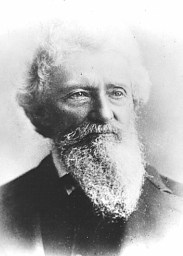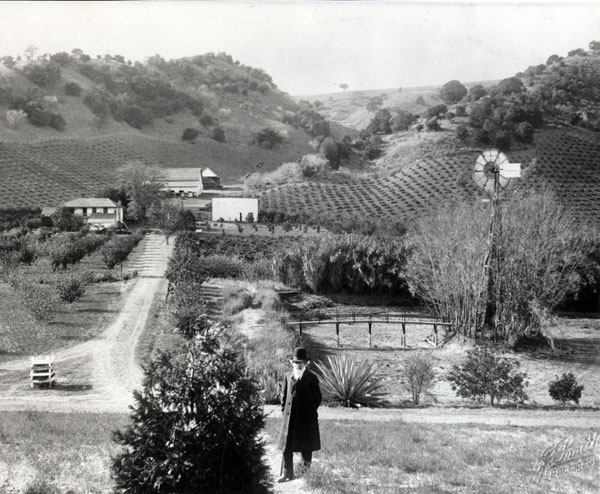the john muir exhibit - people - louie strentzel muir biography - people - john muir exhibit
Dr. John Theophile Strentzel
By the U.S. National Park Service, John Muir National Historic Site
 See also:
See also:
Dr. John Strentzel was born in Lublin, Poland, November 29, 1813. His family was well to do, and able to provide a life of "being attended with all desirable comforts". At age six, he was sent to school along with the sons of officials and nobility. In 1830, he joined in an attempted overthrow of the Russian domination of Poland. When the revolution failed the following year, John Strentzel was forced to flee his homeland and move to Hungary. Here he gained knowledge of vineyard culture and the wine trade. He also began his medical studies at the University of Pesth, Hungary, and received his diploma in 1839.
Dr. Strentzel immigrated to the United States in 1840 and moved west to Texas where he settled and married Louisiana Erwin in 1843. Their first child, a daughter named Louisa (Louie), was born in 1846, and a son, John, in 1848. The family moved to California during the 1849 Gold Rush, enduring many harrowing experiences before settling along the Tuolumne River and establishing a ferry, a hotel and a general store. Later, they took up farming along the Merced River but lost the farm in a flood. A second daughter, Lotta, was born in 1851 but lived only four months.
Seeking a quieter life, the Strentzels moved to the Alhambra Valley near the town of Martinez, California, in 1853. The doctor bought 20 acres of land and used his Hungarian vineyard knowledge to begin experimenting with a wide variety of grapes, fruit and nut trees, as well as ornamental plantings. Importing seeds and cuttings from around the world, Dr. Strentzel employed new scientific methods in horticulture, exhibiting oranges and award-winning wines as early as 1861.
Dr. Strentzel's fortunes increased over the years as demand for his produce grew. He bought additional land and planted large vineyards and orchards that included Muscat, Zinfandel and Tokay grapes, and over 50 varieties of pears. People came to view and write about the famous "Alhambra gardens" of Dr. Strentzel.
Eventually, Dr. Strentzel tried over 1,000 varieties of fruit trees and ornamentals, earning a solid reputation as a pioneer and authority on California horticulture. He contributed articles on his research to numerous publications, gave college lectures on agriculture, and helped establish and lead state and local Grange organizations to promote agricultural interests. He also found time to be a school trustee and president of the Martinez Gas and Electric Company.
The death of the Strentzel's son, John, in 1857, was a crushing blow to the family. Their only remaining child, Louie, received an extensive education and became a pianist of concert caliber. She was devoted to her parents, however, and chose to remain with them on their fruit ranch, helping them run their large and thriving business.
The Strentzels became acquainted with a well-known naturalist and aspiring writer named John Muir in 1874. Muir and the doctor were mutually impressed with each other and a warm friendship began. The Strentzels were delighted when Muir proposed to Louie in 1879. Dr. Strentzel gave the newlyweds 20 acres of land and the Strentzel home to live in when they were married the following year. At age 67, Dr. Strentzel gained the son he
had always wanted.
In 1882, Dr. Strentzel built a 17-room mansion on a knoll overlooking his vast orchards, about a mile from his original home. John Muir took over as ranch manager, overseeing the 2,600 acre operation when the doctor's
health began to fail. Capitalizing on cash crops already established by his father-in-law, Muir secured his own modest fortune over the next ten years, enabling him to resume his writing and conservation career later on.
Dr. Strentzel continued his horticultural work and practiced his medical skills whenever required. On one occasion he saved the life of a man who had been struck in the head with a pickaxe.
Strentzel never forgot his Polish heritage. He kept several scrapbooks on Polish achievements and entertained many Polish artists and writers, among who were Henry Sienkiewicz, author of Quo Vadis, and the famous
Polish actress, Madame Modjeska. And in 1880, the government of Poland presented Dr. Strentzel with a document honoring him for his participation in the 1830 Polish National Uprising.
Perhaps Dr. Strentzel's last years can best be described in his own words. He wrote in a short autobiography: "My faithful companion (Louisiana) and I live very comfortably and quietly in our declining years. We have a commodious house with pleasant surroundings, in the midst of orchards and vineyards in full view of Martinez
and Benicia..."

See also:
Home
| Alphabetical Index
| What's New